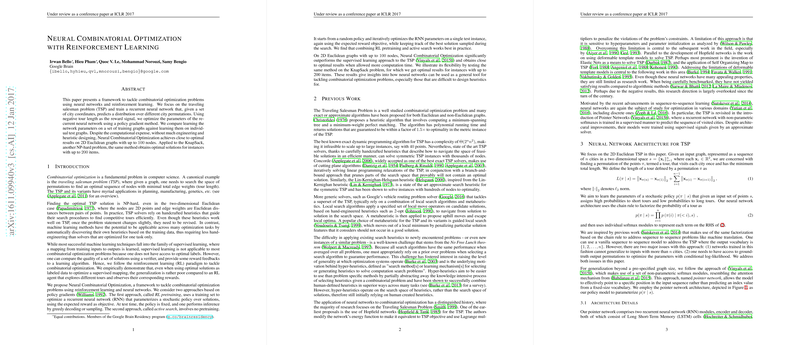Neural Combinatorial Optimization with Reinforcement Learning
The paper "Neural Combinatorial Optimization with Reinforcement Learning" by Irwan Bello and colleagues from Google Brain introduces a novel framework for addressing combinatorial optimization problems using neural networks and reinforcement learning (RL). The authors present a detailed methodology for solving the Traveling Salesman Problem (TSP) and extend their approach to other NP-hard problems such as the Knapsack problem.
Overview
The fundamental challenge addressed in this paper is the combinatorial optimization problem, particularly exemplified by the TSP. The TSP involves finding the shortest possible tour that visits a set of cities exactly once and returns to the origin city. Traditional approaches to this problem, which include exact algorithms and heuristic methods, can be computationally expensive and often require significant hand-engineering to adapt to different problem settings.
Methodology
The proposed methodology leverages Recurrent Neural Networks (RNNs) and policy gradients, a type of RL, to optimize the parameters of a neural network that predicts a distribution over permutations of city coordinates. The negative tour length serves as the reward signal guiding the optimization process. The authors explore two primary learning paradigms:
- RL Pretraining: A recurrent neural network is pretrained on a set of training graphs, optimizing the expected tour length.
- Active Search: This approach skips pretraining and instead optimizes the RNN parameters directly on a single test instance, iterating to refine the solution.
The pointer network architecture, introduced by Vinyals et al., is employed to enhance the generalization capability of the model beyond a fixed graph size. This architecture, composed of an encoder-decoder structure with LSTM cells, allows the model to "point" to specific positions in the input sequence.
Experimental Results
The experiments conducted demonstrate the efficacy of the proposed methods on 2D Euclidean graphs with up to 100 nodes. Key results and observations include:
- Performance: The RL-trained models significantly outperform supervised learning approaches on the TSP, achieving near-optimal solutions with less computational overhead. The RL pretraining-greedy configuration, in particular, demonstrates competitive performance with minimal search.
- Flexibility and Generalization: The approach generalizes well to different problem settings without extensive heuristic tailoring. Applied to the Knapsack problem, the method achieves optimal solutions for instances with up to 200 items.
- Computational Cost: The time-complexity of the proposed methods is competitive with state-of-the-art heuristic solvers. For example, RL pretraining-greedy provides rapid inference while still achieving high-quality solutions.
Implications and Future Work
The implications of this research extend both theoretically and practically. By utilizing neural networks and RL, the framework offers a flexible and generalizable solution to combinatorial optimization problems, reducing the need for problem-specific heuristic design. This has potential applications in various domains such as logistics, manufacturing, and genetics, where combinatorial optimization is prevalent.
Future developments in this area could explore the integration of other neural network architectures and advanced RL techniques to further enhance performance and scalability. Additionally, the framework's adaptability to more complex optimization problems with additional constraints, such as the Traveling Salesman Problem with Time Windows, presents an exciting avenue for further research.
Conclusion
This work by Bello et al. represents a substantial advancement in leveraging neural networks and RL for combinatorial optimization. The framework not only achieves high-quality solutions on benchmark problems like the TSP and Knapsack but also highlights the significant potential for generalizing this approach to a broader class of optimization challenges. The paper's findings suggest that with continued refinement and exploration, neural combinatorial optimization could become a cornerstone technique in solving complex real-world optimization problems.
